|
The routes of the Silk Road
 The
Silk Road was from Chang’an westwards. It was through Lanzhou, Tianshui,
Zhangye, Jiuquan along the Hexi Corridor. Then it reached the Jiayuguan
Pass, which is an important military pass on the Great Wall. After reaching
at Dunhuang, the first key point on the Silk Road, it split into three
different routes in Xinjiang. The southern route ran west along the northern
foot of Kunlun Mountains, via Ruoqiang, Hetian, then reached Kashgar,
another key point on the Silk Road, afterwards went over the Pamirs, and
reached India or passed through Afghanistan and Central Asia to reach
the coast of the Mediterranean Sea or Arabia. The central route meandered
west along the southern foot of the Tianshan Mountains then crossed the
Pamirs and led to Mari in Russia. The northern route rambled along the
northern foot of the Tianshan Mountains, starting at Hami wound through
Turpan, Urumqi, westward reached the Ili River Valley, and led to area
as near the Black Sea. The three routes of the Silk Road ran between mountain
ranges and edges of deserts, going through oases inhabited by ancient
tribes. These tribes also opened some branch roads across mountain passes
to join the three routes together.
The
Silk Road was from Chang’an westwards. It was through Lanzhou, Tianshui,
Zhangye, Jiuquan along the Hexi Corridor. Then it reached the Jiayuguan
Pass, which is an important military pass on the Great Wall. After reaching
at Dunhuang, the first key point on the Silk Road, it split into three
different routes in Xinjiang. The southern route ran west along the northern
foot of Kunlun Mountains, via Ruoqiang, Hetian, then reached Kashgar,
another key point on the Silk Road, afterwards went over the Pamirs, and
reached India or passed through Afghanistan and Central Asia to reach
the coast of the Mediterranean Sea or Arabia. The central route meandered
west along the southern foot of the Tianshan Mountains then crossed the
Pamirs and led to Mari in Russia. The northern route rambled along the
northern foot of the Tianshan Mountains, starting at Hami wound through
Turpan, Urumqi, westward reached the Ili River Valley, and led to area
as near the Black Sea. The three routes of the Silk Road ran between mountain
ranges and edges of deserts, going through oases inhabited by ancient
tribes. These tribes also opened some branch roads across mountain passes
to join the three routes together.The Origin of the Silk Road
In 138BC Hanwudi sent Zhang Qian for the political contact with Yuezhi (a nomadic tribe) in order to ally to attract Huns. Yuezhi was defeated by their enemy the Huns(an ancient nomadic tribe who lived in today’s northwest part of China.) and driven to today’s Northern Afghanistan. Zhang Qian with a delegation of 100 people set out from Chang'an to travel westward. On the way to the west regions, he was captured and detained for 10 years by the Huns. Due to the will of complete his mission, one day he seized a chance and escaped with other colleges. He continued the journey westwards. Finally in 128 BC, Zhang Qian reached Yuezhi. However he was disappointed that Yuezhi was living in peace and well settled in the various oases of Central Asia and had no longer interested in fighting against Xiongnu. So Zhang Qian had to return journey. But On his way back he was captured by Xiongnu again. Finally in 126 BC he was back to Chang’an . After 13 years’ journey, only one companion and Zhang Qian successfully came back to Chang’an.
Although Zhang Qian’s political mission was failed. He obtained very valuable information about the people who lived in western part of China and central Asia. That laid the foundation for the opening through the Silk Road in the Han Dynasty. With the economy developing in the Han Dynasty and the declining of the Huns, China had the ability to Control the vast area of western regions. Han Dynasty even extended the Great Wall westwards in the Gobi desert to protect the ancient trade route. Roman’s fanaticism for silk made the silk business much profitable thus stimulated the development of the Silk Road. In 73AD, Ban Chao was sent by Han Emperor to West Regions on diplomatic mission again. The relationship between the West Regions and the Han Dynasty was strengthened. The trading on the Silk Road became prosperous again.
The Peak of the Silk Road
The fall of the Han dynasty in the early 3rd century once caused Silk Road trade to decline. However, the rise of the Tang dynasty in the 7th century revived the business on Silk Road. The powerful military power, stable social life, the thriving economy and favorable trading policy of the Tang Dynasty made Silk Road reach its peak on its development by the mid 8th century.
The Decline of the Silk Road
By 760 AD, during the Tang Dynasty, trade along the Silk Road had declined. It revived tremendously under the Song Dynasty in the eleventh and twelfth centuries when China became largely dependent on its silk trade. In addition, trade to Central and Western Asia as well as Europe recovered for a period of time from 1276-1368 under the Yuan Dynasty when the Mongols controlled China. The Chinese traded silk for medicines, perfumes, and precious stones. As overland trade became increasingly dangerous, and overseas trade became more popular, trade along the Silk Road declined.
The Significance of the Silk Road
The Silk Road really played an important role in Chinese history. It was not only a trade route but also a cultural exchange route. It had great influence on civilization of East and West. Buddhism was introduced in China via the Silk Road in 1st Century AD and soon it was accepted by Chinese and well spread out. In the Tang Dynasty, Islam, Christianity, Zoroastrianism were introduced in China. Costumes, dance, music instruments, acrobats, and arts from Central Asia came to China via the Silk Road and they influenced on Chinese culture. Fruits such as walnut, cucumber, pepper, and carrot were also introduced from Central Asia. Chinese used silk to trade perfume, glass ware, amber, ivory, gem, silver, and gold. The technology of making sugar was introduced from India. Chinese sericulture, technology of paper-making, printing, compass, and gunpowder were introduced to Arab countries and Europe through business people on the Silk Road. That really influenced the world civilization and history. To some extent, the Silk Road was also an information road.
Travel along the ancient Silk Road
Xi’an is the starting point of the ancient Silk Road. It is famous for the Terra Cotta Warriors and Horses, the Big Wild Goose Pagoda, Huaqing Hot Spring, Xi’an Old City Wall and Tang Emperors’ Tombs.
Lanzhou City is famous for Gansu Provincial Museum, Bingling Thousand Buddha Caves and Labrang Monastery.
Gansu Provincial Museum houses collections of various color-painted potteries of Neolithic Age and treasures of ancient grottoes. In addition, it also displayed precious linen and silk fabrics, books, wooden and bronze vessels, a great many bamboo slips for writing from the Han Dynasty (206 BC-220), frescos and so many other items. The world-famous bronze Galloping Horse's Hoof Stepped on a Flying Swallow, also named as Galloping Horse, is a treasure of Gansu Provincial Museum. Excavated in 1969 in Wuwei County, Gansu Province, the piece depicts a vigorous horse with long tail waving and head rising bird. Three hooves of the galloping horse are in air and the right-back hoof steps on the back of a small flying bird. The bird turns in surprise to look at the big creature on its back. At the same moment, the horse's head also turns slightly in attempt to know what has happened. The whole statue is honored as the mysterious and rare treasure in the history of Chinese ancient sculpture art.
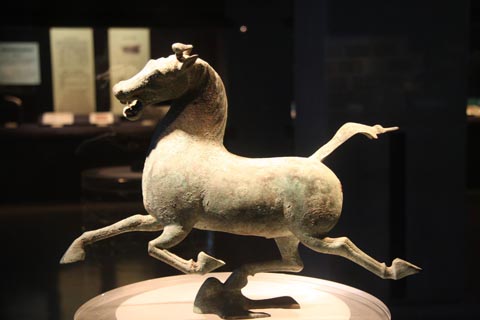 |
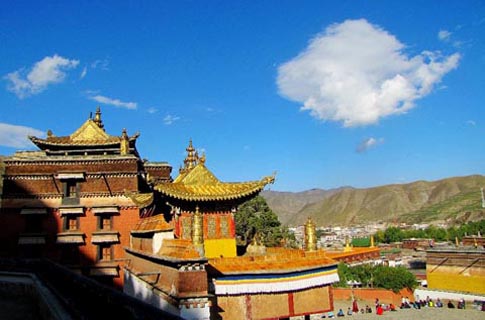 |
Bronze
Galloping Horse's Hoof Stepped on a Flying Swallow |
Labrang
Monastery |
Bingling Thousand Buddha Caves were built in the Western Jin Dynasty (265-316). In the following dynasties, the caves had been excavated many times. There are 694 stone statues, 82 clay sculptures and some 900 square meters of murals, which are all well preserved. Famous for its stone sculptures, Bingling Thousand Temple Caves stretches about 200 meters (about 600 feet) on the west cliff in Dasi Gully. Among the caves, the main characters are Sakyamuni, Kwan-yin, Amitayus Buddha, Maitreya Buddha, and other Buddhas. With elegant postures, flying robes and ribbons, the statues are life-like.
Labrang Monastery is
a Tibetan Buddhist temple. It boasts tens of thousands of statues of Buddha
made of gold, silver, copper, and aluminum. There are statues with ivory,
sandalwood, jade, crystal and clay as the basic materials. These Buddha
statues are all lifelike with kind-looking faces, which give you a real
enjoyment of beauty. In addition, the monastery possesses many Buddha
hats and many Buddhist treasures adorned with pearls, jadeite, agate and
diamonds. The Labrang Monastery holds seven large-scale summon ceremonies
a year, among which the Summons Ceremony in the first lunar month and
the Buddhist Doctrine Explaining Ritual in the seventh lunar month are
the grandest ones.
Jiayuguan Pass is a key point on the Silk Road and it
is also an important military strategic pass on the western end of China's
Great Wall. The buildings we can see today were built in the Ming Dynasty
(1368-1644AD). It was called the First Grandest Pass under the Heaven.
The pass is trapezoid-shaped with a perimeter of 733 meters and with an
area of more than 33,500 square meters. The city wall is 11 meters high.
There are two gates-with one located on each of the east and west sides
of the pass. The pass itself consists of three defense lines -an inner
city, an outer city and a moat. The Great Wall near Jiayuguan pass is
very spectacular.
 |
Jiayuguan
Pass |
Dunhuang was an important
point on the Silk Road. It has many historic relics. Mogao Caves, Echoing-Sand
Mountain and Crescent Spring are most popular tourist attractions.The
Mogao Grottoes, twenty-five kilometers southeast of Dunhuang City, contain
the largest and richest treasure of stone carvings and mural paintings
in China. Carved out along a 1,500-meter precipice, the 492 grottoes stretch
from south to north on the eastern slope of Echoing-Sand Mountain (Mingshashan)
and are divided into five levels. They contain 45,000 square meters of
murals 2,415 painted statues, and five wooden structures. The statues
were all made of clay and colored with paint. Themes of the murals range
fro Buddha portraits and Buddhist stories to fairy tales and pictures
of worshippers.
The Mogao Grottoes were cut during a period of more than
a thousand years from the fourth century century to the fourteenth century
AD. Their discovery at the beginning of the century, after several hundred
years of oblivion, caused a sensation throughout the world.
 |
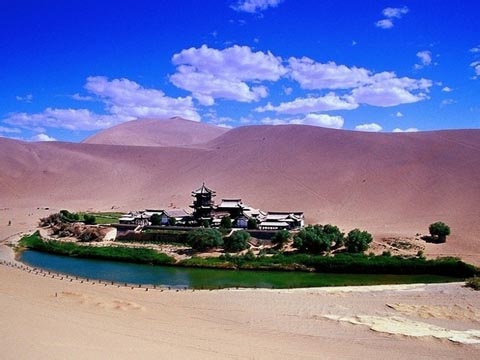 |
Maogao Grottoes |
New Crescent Spring |
 |
 |
Earth Statues |
Mural |
The colored paintings of the Mogao Grottoes feature hold lines, bright
colors, and superb composition. Those made during the Tang Dynasty (618-907AD)
are particularly brilliant.
In 1900, 50,000 manuscripts written in many languages dating from the
Middle Ages were also discovered in a cave where Buhhdist scriptures were
stored. The study of these valuable materials, along with paintings and
statues, has become a subject of worldwide research.
The Crescent Spring lies
6 kilometers south of Dunhuang city, and surrounded by the Echoing-Sand
Mountain, Crescent Spring can be called a natural wonder in the Gobi Desert.
It is 218 meters from west to east, about 54 meters from north to south
and 5 meters deep on an average. It turns along the mountain, wonderfully
existing with the Ming Sha Mountain like twins. "From the early beginning
sands do not fill the spring while the latter never dries". The dunes
"recovers next day after night wind sweeping", while "the
spring mirrors the moon without dust". Having been lying among these
sand dunes for thousands of years, although given many surprise attacks
by sandstorms, Crescent Spring still gurgles clear, and still remains
worthy as the first spring in the desert.
The Echo-Sand Mountain is five kilometers away from the
city of Dunhuang. Seen from afar, the mountain is just like a golden dragon
winding its way over the horizon. As you approach you become aware that
the sand has many colors ranging from red to yellow, green, black and
white. On days when a strong wind blows, the fast shifting sand roars;
but when the wind is little more than a light breeze, the sand produces
gentle, dulcet sounds akin to music. It is the same when you are sliding
down the mountainside. At first, the sand under your feet just whispers;
but the further you slide, the louder the sound until it reaches a crescendo
like thunder or a drum beat. Some say that the sand is singing, while
to others it is like an echo and this is how the mountain gets its name.
Urumqi is the capital City of Xinjinag Uigur Autonomous
Region. It has a lot of attractions such as the Heaven Lake, the Red Hill,
Southern Pasture, the Southern Mosque, and Xinjiang Museum.
Heavenly Lake lies In the middle of Bogda Peak, 110 km
east of Urumqi. Covering 4.9 square kilometers, this crescent-shaped lake
deserves its name, Pearl of Heavenly Mountain. With melted snow as its
source, the water is limpid.
Heavenly Lake, a relic of the Quaternary Period Glacier and its surrounding
geological relics, offers science lovers exploring opportunities. According
to the legendary stories Heaven Lake was the place where Western Queen
and King Mu in the Western Zhou Dynasty (110-771BC) dated and had romantic
stories.
 |
 |
Heavenly
Lake |
Red
Hill |
Red Hill is a symbol
of Urumqi, owing to its uniqueness. The body of the mountain, made up
of aubergine rock, has a reddish brown color, hence, the name Red Hill.
The hill is 1.5km long and 1km wide from east to west. Now it is a popular
park in Urumqi.
Located at the foot of the Tian Shan mountain range, Southern Pastures
is a famous summer resort for forest of emerald green spruce rounds it
while flowers, flocks and herds strew it. West White Poplar Gully is the
most typical sights in the Southern Pastures.
The Xinjiang Museum was built in 1953 with an area of
7,800 sqm. The exhibitions in the museum can be divided into minority
cultures objects, cultural relics excavated on the ancient Silk Road.
The Southern Mosque is in the downtown of Urumqi in Xinjiang.
It is an important historic heritage site. This center of Moslem worship
was built in 1919 and subsequently renovated on three different occasions.
Covering an area of about one acre, the mosque accommodates 1,000 Moslems.The
prayer hall is covered with a variety of glazed tiles and the ceiling
is decorated with colorful patterns of flowers and plants. There are also
22 flying dragons carved on the ridge that add to the building's magnificence.
Turpan has a lot of attractions such as the Ancient City
of Gaochang, Jiaohe Ancient City Relics, Flaming Mountain,Bizalkik Thousand
Buddha Caves, Karez systems, and the Grape Valley.
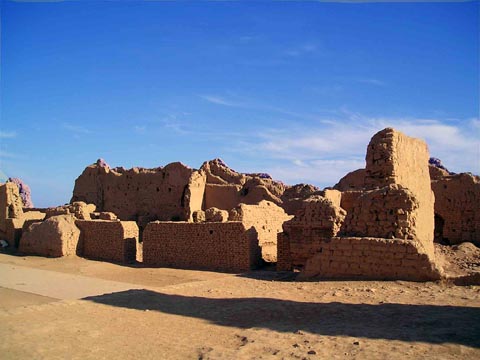 |
 |
Ancient
City of Gaochang |
Ancient
City of Jiaohe |
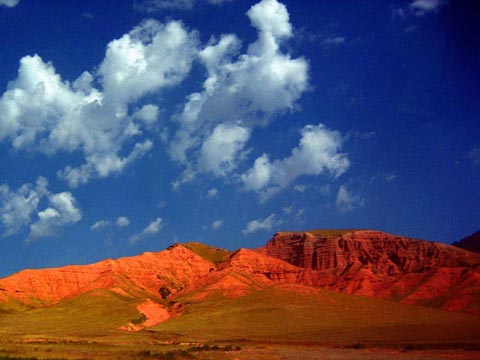 |
 |
Flaming
Mountain |
Grape
Valley |
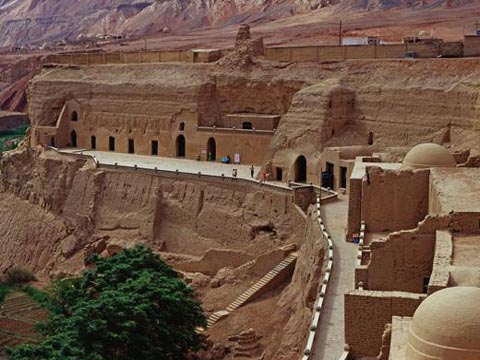 |
 |
Bizalkik
Thousand Buddha Caves |
Karez
Systems |
The Ancient City of Gaochang
is 46 kilometers southeast of Turpan near the 'Flaming Mountains'. Built
in the first century B.C., it used to be a garrison town and later became
a key point along the ancient Silk Road. The practice of Buddhism led
to the establishment of many monasteries and temples. In the ninth century,
the Uigur established the Kharakhoja Kingdom here. The city was burnt
down around the 14th century, during a period of warfare that lasted 40
years. The ruins originally consisted of three parts: the inner and outer
cities, and a palace complex. The inner city is a 3-kilometer long rectangle,
of which the western and eastern sections are well preserved. Several
earthen platforms are still visible. There are two temple remains worth
a visit.
Jiaohe Ancient City Relics is also worth seeing. It has
2,300 years history. Once it was the capital city of Cheshi State. Jiaohe
distinguishes itself from other ancient cities owing to three features.
First, it had only two city gates, the South and East Gates. The main
South Gate vanished long ago, leaving a huge breach. The East Gate cut
by the cliff was virtually non-existent. Second, the city faces cliffs
on three sides, so there are no city walls commonly seen in other ancient
cities. Third, all the buildings were dug from earth and wood was rarely
used. It was very prosperous in the Tang Dynasty but declined later on.
Bizalkik Thousand Buddha Caves stand high on the cliffs
of west Mutou Valley under the Flaming Mountain 45 km (28miles) east of
Turpan. Of the 83 original caves, 57 caves currently remain. The murals
cover an area over 1, 200 square meters in more than 40 caves.
Beginning in the Southern and Northern Dynasties, the construction experienced
Tang, the Five Dynasties, Song and Yuan with great historical value to
study Buddhism in northwest part of China.
Karez systems are the crystallization of ancient people's
diligence and intelligence. At its peak, the karez irrigation system exceeded
5,000 km and was also referred to as 'the underground Great Wall'. It
is among the three ancient major irrigation projects with the other two
being Ling Canal and Dujiangyan.
Karez systems are the life source of Turpan. In a sense, without the karez,
there would be no Turpan culture. According to records, the history of
the karez in Xinjiang dates back to 103B.C. Karezes have been found in
Iran, the Sahara, etc., but the ones in Turpan are the most complete.
Currently there are still over 400 systems.
Karez systems are very delicate irrigation systems made up of vertical
wells, underground canals, above-ground canals and small reservoirs. The
vertical wells are for ventilation, digging and maintenance of the karez.
The bottoms of all the vertical wells are connected so that water can
pass through. The underground canal is about 2 meters high and covered
with earth to resist the heat. The surface canals, connected to the underground
ones, are not more than 1 meter wide with trees planted on both sides
to prevent evaporation. Melting snow from the Tianshan Mountain is the
water source of the karez. Water is collected by vertical wells and conducted
by the underground canals to the oasis.
The Grape Valley is 13 km away from Turpan. It extends
8km from north to south and of 0.5km from east to west. This green paradise
of 400 hectares is covered with vineries.
The Grape Valley Was supplied water by Karez System. Every single grape
is crystal and watery-some are as green as emerald; some as red as agate,
some as small as pearls while others are like olives. Among dozens of
kinds of grapes, white seedless grape is reputed as a green pearl with
the sugar content as much as 22%. Every year over 300 tons of raisins
are made here.
Sightseeing in Korla includes Yadan Physiognomy and Relics
of Ancient Loulan.
'Yadan' is a kind of geomorphic feature in arid regions. The formation
of Yadan features is attributed that the strong winds always erode the
loose earth structure in the arid area. Lop Nur Area is a very tipical
Yadan area. The cluster of eroded mounds are scattered mainly in the north,
west and east sides of the Lop Nur Area.Usually a mound is about 10-20
meters high with an average length of over 200 meters. Most mounds are
covered with a thick crust of salt and in the sunshine these mounds shine
like silver. The Yadan area to the northern side of the Lop Nur Area is
named 'Dragon City'. These mounds vary in height, length, width and shapes.
They are in the shape of houses, pavilions, towers, castles, cars, boats,
animals and human beings, etc. People say that it is one hundred percent
a mound city. More amazingly, one can hear the noise of the 'city'. There
are dogs barking, birds singing, cars hooting, bells ringing, children
playing and crying, and traders and buyers bargaining. All these effects
are the results of the wind roaring against the mounds.
One of the great mysteries in Chinese history is the disappearance of
the ancient city of Loulan. The city was located about 300 km northeast
of Ruoqiang County, Xinjiang Uygur Autonomous Region. It is on the west
bank of Lop Nur Lake.
According to history, Loulan was established as a kingdom
in 176 B.C. and flourished for over 800 years. The city was like an oasis
traversed by a limpid river and situated next to a bountiful lake. The
city had a population of over 14,000 including an estimated 3,000 soldiers
guarding the safety of the kingdom. Many residents made a living fishing
and hunting. As one of the major stops on the old Silk Road, the city
was a center for the trading of silks, teas, fruit and jewels with the
inland. Merchants also used Loulan as a stopover in their travels. In
short, the kingdom was booming economically while serving as a peaceful
and paradisiacal environment for its citizens and visitors. Roughly around
the year 630, Loulan suffered a natural disaster. Due to humans' unceasing
deforestation, raging sandstorms covered the region and made it transform
into a desert.
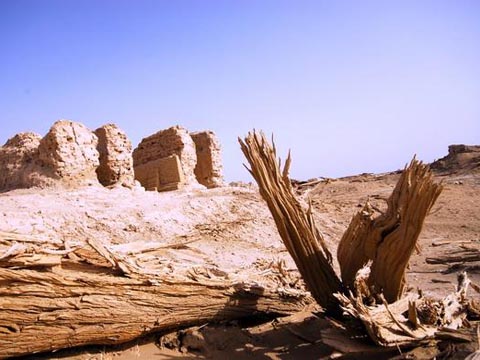 |
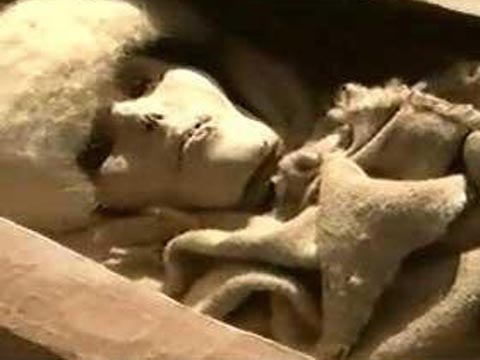 |
Ancient
Loulan Ruins |
Loulan
Beauty |
At the beginning of last century, a Swedish explorer Sven Hedin accidentally
discovered the city buried in desert in his exploration. Discovery startled
the world from then to present.
In recent years some archeological finds from that area can date back
to 5000years ago. They also found manuscripts from the Han Dynasty (206
BC-220 AD) as well as silk, pottery, bronze ware, glassware, and ancient
currency. A woman mummy was also found and it was called 'Loulan Beauty'.
The terrible weather and badly circumstance in Loulan made the exploration
there difficult. However, the mysterious ancient city still attracts many
adventurers.
The tour in Kashgar
may include the most thee popular places such as Abakh Khoja Tomb, Id
Kah Mosque and the East Gate Bazaar.
Five kilometers northeast of Kashgar, an ancient Islamic building nestles
among poplar trees. With glazed tiles shining in the sun, its tower points
to the azure sky. It is a masterpiece of Uigur architecture, Abakh Khoja
Tomb. It was a 17th Century family cemetery of the Kashgar area Islamic
leader. Built from 1640, the tomb covers an area of about five acres.
Just inside the gate is a large rectangular courtyard made up of a gate
tower, worship walls, Doctrine-Teaching Hall, and tomb chamber. Fifty-eight
tombs provide resting places for five generations of 72 people in the
Abakh Khoja family. All coffins are covered with gorgeous silk and satin.
Abakh Khoja Tomb is admired as a well-preserved Islamic
architectural complex not only in Xinjiang, but throughout Central Asia.
'Id Kah' means 'a place of praying and celebrating in festivals.
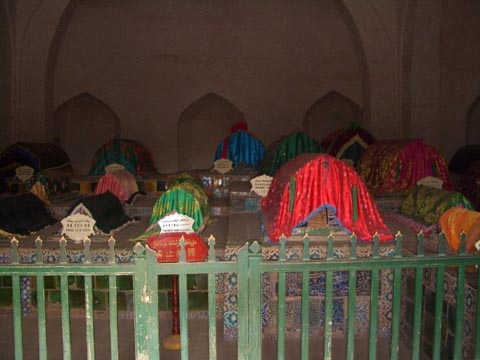 |
 |
Abakh
Khoja Tomb |
Id
Kah Mosque |
The Id Kah Mosque is
located on the central square in Kashgar City. As the biggest mosque in
China, it is a group of old Islamic constructions with strong ethnic style
and religious features. The present Id Kah Mosque was built in 1442 as
a very small structure. Several renovations and enlargements have created
it with today's scale and style. The whole complex occupies 16,800 square
meters and consists of the courtyard, the Hall of Prayer, and the gate
tower and as well as some other attached structures. Every day thousands
of worshippers come here to pray. Every Friday afternoon around 5000 Muslims
gather here to worship. During religious festivals all the Muslims tens
of thousand Muslims come to this sacred place to celebrate. At prayer
time, the mosque, the square, the streets and the roads all around are
full of piously kneeling Muslims. Afterwards, all the people get together
on the square in front of the Id Kah Mosque and dance to show their happiness.
East Gate Bazaar is the most famous bazaars in Kashgar
due to its biggest scale, rich articles and biggest number of customers.
There are around 4000 stalls there. So many commodities from Central Asia
and China are being sold there. Many business men from Central Asia are
doing business there. It made Kashgar a prosperous commercial city in
Central Asia. Famous local handicrafts such as knives and hats are very
welcome. When visiting the East Gate Bazaar you can imagine the scene
of business of the ancient Silk Road.
Mobile:(+86-1350 110 3837) Wechat:(13501103837) E-mail: chinasilkrug@msn.com